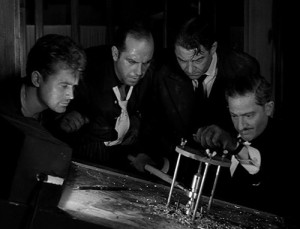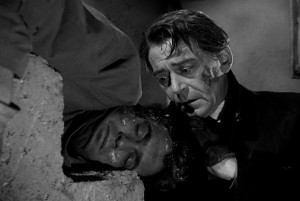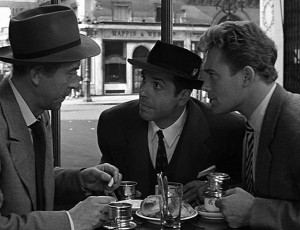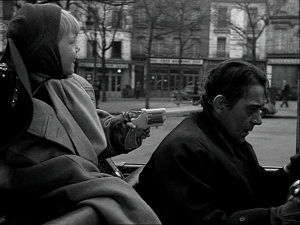
The blacklist that shrouded the Hollywood community in suspicion, paranoia, and tragedy during the 1940s and ’50s, a steadily spreading outgrowth of the tactics formulated and executed by the House Un-American Activities Committee (HUAC), would leave its tarnishing mark on many in the film industry: screenwriters, actors, producers, directors. Seemingly all branches of the motion picture industry were affected by the political upheaval of the time. Some individuals were admittedly marginal in the annals of film history; some were prominent figures with distinguished careers; all were working men and women who, in many cases, found themselves blindsided by the sudden furor.
This back-drop against which one typically places the life and career of Jules Dassin is crucial to his biography and a clear understanding of his working processes, but it can also be a distraction. There is no denying the impact — Dassin was named by colleagues as a former Communist (which he briefly was in the late 1930s); he was subsequently subpoenaed by HUAC in 1952, was blacklisted after refusing to testify, and then chose to leave the United States for France the following year. That, of course, is going to affect anyone, especially a director like Dassin who, with several titles to his credit, including the classics Brute Force (1947), The Naked City (1948), Thieves Highway (1949), and Night and the City (1950), was developing a cinematic proficiency of considerable distinction. Still, as with Elia Kazan, his own controversial role in the HUAC investigations, and his succeeding masterpiece, On the Waterfront (1954), one’s take on Dassin’s work, especially his post-HUAC output, is always prefaced with, or complicated by, how/why/if his films reflected or were a direct result of his personal struggles (just like this piece has been so far). His places of production changed, granted, and his general manner of filmmaking in Europe was obviously going to be different than that in Hollywood, but a filmmaker’s talent is there no matter what. What’s on the screen is what truly represents a film’s significance and quality. That’s why, after one attempts to sweep away this subterfuge of baggage and focus on the movie itself, it becomes easier to see Dassin’s Rififi (1955), his first film made as an expatriate, as the exceptional film that it is, regardless of troubled biographical back-story. Where, when, how, and why Rififi was made is important to history, no question, but its taut, supremely well-paced narrative, technical brilliance, and extraordinary photography raises the film and Dassin himself above the clamor.

Despite not speaking the language, despite the aforementioned drama still fresh, and despite prior trouble getting film work (Dassin called the period between the blacklist and Rififi “the void”), Rififi nevertheless ended up being a remarkable achievement, part heist/crime film, part noir. These were genres well tread by Dassin before. The immediately preceding four features noted above were marked by their attention to gritty detail, their use of actual location, their atmospheric lighting and set design, and their focus on the criminal underworld — “I think I am a crook at heart,” said Dassin, also acknowledging that he liked “authority to be conquered.” There was also already a rich tradition of such films in France, taking into account everything from Louis Feuillade’s silent serials to Marcel Carné’s atmospheric dramas of the 1930s, to Jacques Becker’s Casque d’Or (1952) and Touchez Pas au Grisbi (1954) released just before Rififi. Here though, one gets the best of both worlds: an American filmmaker in Paris making the type of film he does best, for a country and an audience that truly appreciated the form.
When our “hero” Tony le Stéphanois (Jean Servais) is first introduced (only after lingering close-ups of playing cards, cigarettes, and ashtrays, shot in a kind of blatant and tangible detail that reoccurs throughout the film) it’s as a worn, weary, sickly, and somewhat debased ex-con gambler. He has been playing cards all night and he’s out of money. So, he calls Jo (Carl Möhner), a friend and former criminal associate. Jo has a deep respect and love for Tony (Jo’s son is named Tonio), plus he owes him; Tony did time only after not “squawking,” thus leaving Jo to go free. Jo spots Tony the money. He’s the back up (“somebody’s gotta be”), in a procedure that is apparently quite common. This has happened before, but Jo remains faithful.
The two move on to meet a new acquaintance, Mario (Robert Manuel), a more flamboyant character who divulges his latest scheme, a caper involving the heist of some jewels from Mappin & Webb. It’s a proposal with much to gain and much to risk. Tony is reluctant. He is, after all, a beaten down shell of his former self, with a persistent cough only adding to the uncertainty of his abilities and physical state. Being in the noir lineage, once the key female character enters the picture — not quite a femme fatale, Mado (Marie Sabouret) is Tony’s former lover who now sees the corrupt gangster and nightclub owner Louis Grutter (Pierre Grasset) — Tony’s hesitance is swayed. Sympathies are unquestionably with Tony from the very beginning of Rififi (“Rififi” meaning “rough n’ tumble,” according to a nightclub musical number). But when he brings Mado back to his apartment and proceeds to make her strip, to whip her with his belt, and to then kick her out, we are left wondering about this man’s morality. Strange though, just how fast this behavior is forgotten as the film proceeds. In any event, apparently Mado follows money. Tony needs money. Perhaps his motivation for joining in on the caper is as simple as that.

With Tony signed on, all that’s needed is someone to handle the safe. For that, Mario suggests bringing in an expert, Cesar (played by Dassin himself, using the pseudonym Perlo Vita). He’ll agree, asserts Mario, just to be able to work with the famed Stéphanois — this is the first real sense we get of just who Tony used to be, his reputation one of great renown and esteem. This rounds out the likable and competent quartet, and with the decision settled, the duration of the film, about 90 minutes still, focuses on the heist itself and the aftermath.
Without giving away the events that occur following the theft (one of which includes a betrayal, perhaps the most plausible element of the film echoing some sense of Dassin’s HUAC familiarity), attention must be, and always is, given to the heist sequence. There are some moments in film history that are consistently cited for their brilliance. Everyone knows them, everyone recognizes the skill; it’s basically seen as a matter of fact that such and such a scene/shot/sequence is simply genius, no doubt about it. Rififi’s 30-plus minute B & E, with not a word spoken and no music, is one such example. Production notes point out that Dassin was never a fan of Auguste le Breton’s source novel, “Du rififi chez les hommes.” In it, the heist is a “mere 10-page throwaway” that occurred early in the 250-page text. By comparison, the deft, meticulous, professional execution of the film’s heist, and Dassin’s similarly adept construction of it, is astonishing. The four men move and operate with a distinguished sense of purpose and grace; it’s balletic the way their respective duties are acted out, each coordinated to move in accordance to the action of others (Cesar even wears ballet shoes to help keep quiet).
By this point, Rififi has already integrated many of the crime film’s staple ingredients. There’s the street-wise jargon (“rod,” “sparkler,” “busting chops”) and the settings are notably familiar, from the glittering nightclub, to the streets with perpetually wet cars and pavement illuminated by a dizzying hue of neon phosphorescence, to claustrophobic backrooms and shabby apartments. (These scenic visuals benefit greatly from Philippe Agostini’s black and white cinematography; having worked with Carné, Bresson, and Ophüls, among others, he knew a thing or two about composing impressive imagery.) In the presentation of these generic necessities, and especially in the bravura heist sequence, Dassin further distinguishes the film by his precise direction of carefully arranged shots and sequences. Everything about Rififi feels as intricately deliberate as the film’s famous larcenous centerpiece.

In an ironic career twist, Rififi proved to be Dassin’s most successful film to date, critically and commercially; among its accolades was the Best Director prize at the 1955 Cannes Film Festival (the film was also nominated for the Palme d’Or). Successes followed with Never on Sunday (1960) — another Palme d’Or nomination, as well as Oscar nods for Dassin’s script and direction — and Topkapi in 1964, a Rififi-esque tale of crime that garnered most of its plaudits for Peter Ustinov’s performance. Dassin’s final feature was Circle of Two in 1981. He would pass away 27 years later, at the age of 96, having lived long enough to see his politics forgotten and his work remembered.
Rififi was released on Blu-ray and DVD by Criterion Collection on January 14th, 2014.
This REVIEW was previously published in FILM INTERNATIONAL
No comments:
Post a Comment